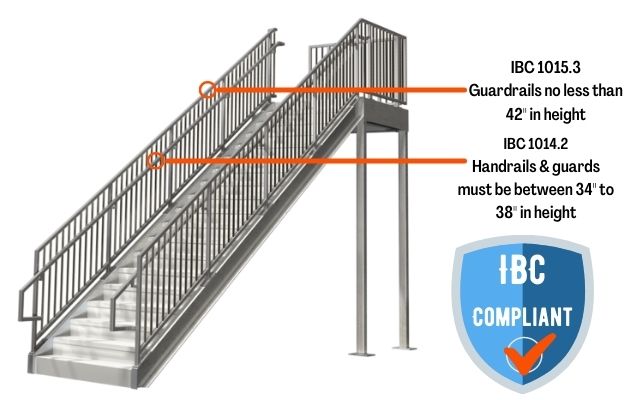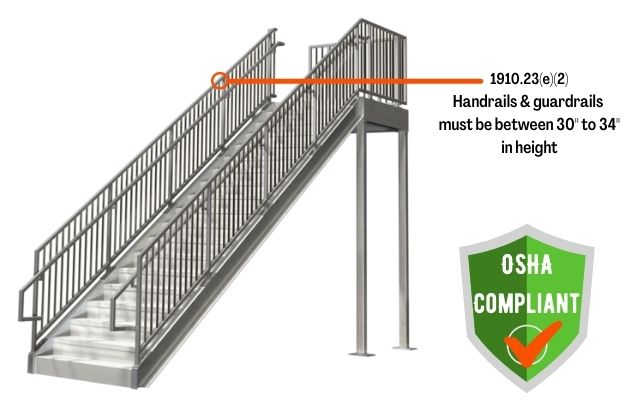No matter how you call it, stair rails, guardrails, or handrails — some standards must be met when it comes to its height. This height requirement is put forth to ensure the safety of people or workers using these stairs. These standards protect workers from falls, one of the leading causes of industrial injuries, while ensuring facilities meet regulatory requirements.
Railing Height Requirements at a Glance
Different regulatory bodies establish specific height requirements for handrails and guardrails to ensure safety across various applications:
| Code Body | Application | Handrail Height | Guardrail Height |
|---|---|---|---|
| OSHA | Industrial/Workplace | 30″ to 38″ | 42″ (±3″) |
| IBC | Commercial Buildings | 34″ to 38″ | 42″ minimum |
| ADA | Accessible Design | 34″ to 38″ | Not specified |
| NBC (Canada) | Residential | 34″ to 42″ | 36″ minimum |
| NBC (Canada) | Commercial | 34″ to 42″ | 42″ minimum |
International Building Code (IBC) Standards
The IBC establishes strict requirements for commercial applications. Handrail heights must fall between 34 and 38 inches (854-965 mm), while guardrail heights must be at least 42 inches (1,067 mm). These standards apply to all commercial buildings open to the public and ensure consistent safety across different facilities.
For stairs to be IBC-compliant in height:
1014.2 – Handrail height must not be less than 34 inches (854 mm) or more than 38 inches (965 mm).
1015.3 – Guardrail height must not be less than 42 inches (1,067 mm) in height.

OSHA Standards
For industrial facilities, OSHA provides comprehensive requirements that SafeRack specializes in meeting. The regulations specify that stair rail systems must have a vertical height between 30 and 38 inches from the upper surface of the top rail to the surface of the tread.
Key OSHA requirements include maximum riser heights of 9.5 inches, minimum tread depths of 9.5 inches, and minimum stair widths of 22 inches. For platforms, runways, or stairs taller than 4 feet, guardrails become mandatory with no substitutions permitted.
OSHA stair requirements: 1910.23(e)(2) A stair railing shall be of construction similar to a standard railing, but the vertical height shall be not more than 34 inches nor less than 30 inches from an upper surface of top rail to the surface of tread in line with the face of the riser at the forward edge of the tread.

What’s the difference between the IBC and OSHA stair standards?
ADA Accessibility Requirements
The Americans with Disabilities Act mandates specific standards for accessible design. Handrails must be installed on both sides of stairs and ramps with a rise greater than 6 inches, maintaining heights between 34 and 38 inches above the stair nosing or ramp surface. When children are primary users, a second handrail at 28 inches maximum height is recommended with at least 9 inches of vertical clearance between rails.
Canadian National Building Code (NBC)
Canada’s NBC provides distinct requirements based on application type. For guards protecting drops between 24 inches and 5’10”, a 36-inch guard railing is required, while drops above 5’10” require 42-inch guards. The 2015 NBC update removed certain climbability restrictions, allowing horizontal elements in guards protecting levels up to 4.2 meters.
Critical Safety Considerations
Proper handrail and guardrail installation involves more than just height compliance. Rails must withstand at least 200 pounds of pressure applied from any direction, and the gripping surface must remain free of sharp or abrasive elements. Continuity is essential—handrails must be continuous within the full length of each stair flight without rotation in their fittings.
SafeRack’s Compliance Solutions
SafeRack’s comprehensive product portfolio ensures facilities meet all applicable safety standards. Our gangways, safety cages, and mobile access units incorporate OSHA-compliant designs while our on-site safety evaluations identify potential hazards and ensure proper railing heights. Through our proprietary configurator tool, we provide same-day 3D renderings with built-in compliance verification, eliminating costly engineering errors.
Installation Best Practices
Successful implementation requires attention to several factors beyond basic height requirements. Uniformity is critical—riser heights and tread depths must remain consistent between landings to prevent trips and falls. Landings must match stair width with at least 30 inches of depth for OSHA applications or 48 inches for IBC requirements.
Avoiding Common Compliance Mistakes
Facilities often overlook critical details that result in violations. Common errors include using chains as guardrail substitutes, inconsistent handrail heights along runs, and inadequate clearance between handrails and walls. Regular inspections and preventative maintenance help identify issues before they become costly violations, which can reach $10,000 per occurrence.
Whether upgrading existing facilities or designing new installations, SafeRack provides the expertise, products, and services to ensure complete compliance with stair railing height requirements. Our Regional Area Managers conduct thorough assessments to optimize safety while maintaining operational efficiency, making SafeRack your trusted partner for fall protection solutions.



